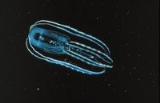
Lobata
Encyclopedia
Lobata is an order of Ctenophora in the class Tentaculata
with smaller tentacle
s than other ctenophores, and distinctive flattened lobes extending outwards from their bodies.
They are about 25 centimetres (9.8 in) long.
). Between the lobes on either side of the mouth, many species of lobates have four auricles, gelatinous projections edged with cilia that produce water currents that help direct microscopic prey toward the mouth. This combination of structures enables lobates to feed continuously on suspended plankton
ic prey.
Lobates have eight comb-rows, originating at the aboral pole and usually not extending beyond the body to the lobes; in species with (four) auricles, the cilia edging the auricles are extensions of cilia in four of the comb rows. Most lobates are quite passive when moving through the water, using the cilia on their comb rows for propulsion, although Leucothea has long and active auricles whose movements also contribute to propulsion. Members of the lobate genera
Bathocyroe
and Ocyropsis
can escape from danger by clapping their lobes, so that the jet of expelled water drives them backwards very quickly.
Unlike cydippids, the movements of lobates' combs are coordinated by nerves rather than by via water disturbances created by the cilia, and combs on the same row beat together rather than in Mexican wave style. This may have enabled lobates to grow larger than cydippids and to have shapes that are less egg-like.
An unusual species first described in 2000, Lobatolampea tetragona, has been classified as a lobate, although the lobes are "primitive" and the body is medusa
-like when floating and disk-like when resting on the sea-bed.
Tentaculata
Tentaculata is a class of comb jellies. The common feature of this class is a pair of long, feathery, contractile tentacles, which can be retracted into specialised ciliated sheaths. In some species, the primary tentacles are reduced and they have smaller, secondary tentacles...
with smaller tentacle
Tentacle
A tentacle or bothrium is one of usually two or more elongated flexible organs present in animals, especially invertebrates. The term may also refer to the hairs of the leaves of some insectivorous plants. Usually, tentacles are used for feeding, feeling and grasping. Anatomically, they work like...
s than other ctenophores, and distinctive flattened lobes extending outwards from their bodies.
They are about 25 centimetres (9.8 in) long.
Anatomy
The lobates have a pair of lobes, which are muscular, cuplike extensions of the body that project beyond the mouth. Their inconspicuous tentacles originate from the corners of the mouth, running in convoluted grooves and spreading out over the inner surface of the lobes (rather than trailing far behind, as in the CydippidaCydippida
Cydippida is an order of comb jellies. They are distinguished from other comb jellies by their spherical or oval bodies, and the fact their tentacles are branched, and can be retracted into pouches on either side of the pharynx.-Anatomy:...
). Between the lobes on either side of the mouth, many species of lobates have four auricles, gelatinous projections edged with cilia that produce water currents that help direct microscopic prey toward the mouth. This combination of structures enables lobates to feed continuously on suspended plankton
Plankton
Plankton are any drifting organisms that inhabit the pelagic zone of oceans, seas, or bodies of fresh water. That is, plankton are defined by their ecological niche rather than phylogenetic or taxonomic classification...
ic prey.
Lobates have eight comb-rows, originating at the aboral pole and usually not extending beyond the body to the lobes; in species with (four) auricles, the cilia edging the auricles are extensions of cilia in four of the comb rows. Most lobates are quite passive when moving through the water, using the cilia on their comb rows for propulsion, although Leucothea has long and active auricles whose movements also contribute to propulsion. Members of the lobate genera
Genus
In biology, a genus is a low-level taxonomic rank used in the biological classification of living and fossil organisms, which is an example of definition by genus and differentia...
Bathocyroe
Bathocyroe
Bathocyroe is a genus of ctenophores, the only genus in the family Bathocyroidae....
and Ocyropsis
Ocyropsis
Ocyropsis is a genus of oceanic lobate ctenophores. Species include:* Ocyropsis crystallina * Ocyropsis fusca * Ocyropsis maculata * Ocyropsis pteroessa Bigelow, 1904...
can escape from danger by clapping their lobes, so that the jet of expelled water drives them backwards very quickly.
Unlike cydippids, the movements of lobates' combs are coordinated by nerves rather than by via water disturbances created by the cilia, and combs on the same row beat together rather than in Mexican wave style. This may have enabled lobates to grow larger than cydippids and to have shapes that are less egg-like.
An unusual species first described in 2000, Lobatolampea tetragona, has been classified as a lobate, although the lobes are "primitive" and the body is medusa
Medusa (biology)
In biology, a medusa is a form of cnidarian in which the body is shaped like an umbrella, in contrast with polyps. Medusae vary from bell-shaped to the shape of a thin disk, scarcely convex above and only slightly concave below...
-like when floating and disk-like when resting on the sea-bed.
External links
- Battle of the Black Sea Jellies - Illustrated article of the Black Sea Jellies

